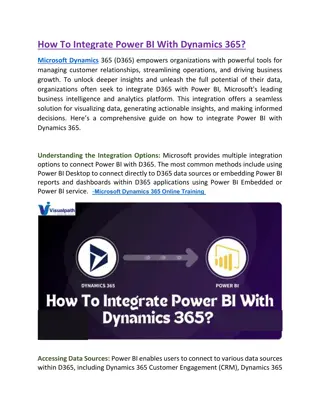Understanding Process Dynamics in Control Systems
Explore the importance of terms like gain, time-constant, integrator, and time-delay in identifying and tuning control systems. Learn how to represent time-constant systems mathematically and derive transfer functions. See examples of applying these concepts to a simulated heated tank system. Gain insights into reading system characteristics from step responses. Dive into the mathematical modeling of dynamic systems for practical applications.
Download Presentation

Please find below an Image/Link to download the presentation.
The content on the website is provided AS IS for your information and personal use only. It may not be sold, licensed, or shared on other websites without obtaining consent from the author. Download presentation by click this link. If you encounter any issues during the download, it is possible that the publisher has removed the file from their server.
E N D
Presentation Transcript
Course: Process Control, NMBU Dec 2017 - April 2018 Process dynamics By Finn Aakre Haugen, PhD, TechTeach (finnhaugen@hotmail.com) F. Haugen. Process Control. NMBU. 2017. 1
Terms Gain Time-constant Integrator (or accumulator) Time-delay Why are these terms important? To give names to dynamic properties of physical systems To make you identify and understand dynamic properties Can be used in controller tuning - using model-based methods (e.g. Skogestad s method - to be described later in this course) F. Haugen. Process Control. NMBU. 2017. 2
Definition of time-constant systems Time-constant systems can be represented with the following differential equation, where u is the system input and y is the output: T is the time-constant. K is the gain. From this differential equation we can calculate the following transfer function from input u to output y: This transfer function is the standard transfer function of a time- constant system. F. Haugen. Process Control. NMBU. 2017. 3
K and T in the step response By applying a step at the input of the system, you can read off K and T from the step response at the output. Step response: Input step ys U K = Output / Input = ys/U = delta y / delta u (at steady-state!) T is the 63% response time t F. Haugen. Process Control. NMBU. 2017. 4
Simulator: Time-constant F. Haugen. Process Control. NMBU. 2017. 5
Example: Liquid tank with heating Simulator: Heated tank (Mathematical model on next slide.) F. Haugen. Process Control. NMBU. 2017. 6
Mathematical model of heated tank Energy balance: From this differential equation we can derive the following transfer functions, assuming neglected heat transfer (Uh=0) (Delta indicates deviation from operating point ): Time-constant and gains: If the heat transfer is neglected (Uh=0), the time-constant is simply mass divided by mass flow: Let's see if m/F is equal to the "experimental" time-constant as read off on the simulator: Heated tank F. Haugen. Process Control. NMBU. 2017. 7
Definition of integrator systems Integrator systems can be represented with the following integral equation, where u is the system input and y is the output: Ki is the integrator gain. An integrator can be termed accumulator as it accumulates the inputs: y(tk) = Ki * [u(t0) + u(t1) + + u(t0)]*dT The above integral equation corresponds to this diff. equation: The transfer function from input to output is F. Haugen. Process Control. NMBU. 2017. 8
Step response of an integrator The step response is a ramp: Input (step) Output (ramp) F. Haugen. Process Control. NMBU. 2017. 9
Simulators: Integrator Liquid tank (Mathematical model on next slide.) F. Haugen. Process Control. NMBU. 2017. 10
Mathematical model of liquid tank Mass balance (assume valve is closed): A * dh/dt = qin qout = qin Kp*up (pump) dh/dt = (1/A) * (qin qout) = (1/A) * (qin Kp*up) which is on the standard form of an integrator (except in our example we have two input signals, qin and qout) F. Haugen. Process Control. NMBU. 2017. 11
Time-delay (or transport-delay, dead-time) Example: Conveyor belt (Outflow is equal to time-delayed inflow.) Transfer function: F. Haugen. Process Control. NMBU. 2017. 12
Simulator: Time-delay F. Haugen. Process Control. NMBU. 2017. 13
Very hard questions: 1. Is there a time-delay between readings at sensor FT1 and sensor FT2? FT1 FT2 Isolation Pipeline Liquid TT1 TT2 2. Is there a time-delay between readings at sensor TT1 and sensor TT2? F. Haugen. Process Control. NMBU. 2017. 14
Combined dynamics Example: Wood-chip tank Level control of wood-chip tank How will you characterize the dynamics of this system? F. Haugen. Process Control. NMBU. 2017. 15























